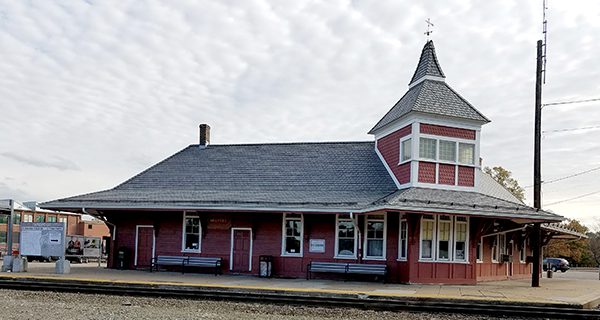Commuters using Walpole’s Union Station to get to and from work on the MBTA will now notice a new plaque signifying the structure’s status on the National Register of Historic Places.
The plaque, funding for which was donated by Walpole native Colin Harding and was installed in May, represents the culmination of years of research and work by members of the Walpole Historical Commission and Walpole Historical Society with the help of consultant Kathleen Broomer.
The Historical Commission contracted with Broomer, with funding from the Rockland Federal Credit Union, to nominate Union Station to the National Register in 2013. It was formally added to the National Register in April 2016.
A ceremony is set to be held Saturday, September 22, at 9:00 a.m. to formally commemorate the plaque, and to thank those who helped contribute to the building being put on the National Register. The public is welcomed to attend to help commemorate this historic landmark.
Union Station, located at 275 West Street, is a wood-framed building constructed in 1893, and occupies the foundation of an earlier station that had burned down. According to its National Register of Historic Places nomination, it is a “well-preserved and uncommon example of a wood-frame, late 19th century railroad station.” It was constructed by Melzar W. Allen of Walpole. It is one of the few remaining passenger stations in Massachusetts that was likely inspired by prominent architect Henry Hobson Richardson’s stone railroad stations.
The station is situated at the intersection of two railroad lines - originally, the New York & New England Railroad operated on the east-west tracks, and the New York, New Haven & Hartford Railroad operated on the north-south route. By 1900, both lines were operated by the New Haven Railroad, as the Midland Division on the east-west route, and as the Old Colony Division on the north-south route. The east-west tracks are now used by the MBTA commuter rail, and the north-south tracks are used by freight trains. It is the oldest station remaining on these two lines, still owned and actively used by the MBTA.
The interior remains largely the same as it was in 1893 - with a large waiting room, restrooms at their original locations, and former ticket and baggage handling rooms. The waiting room was originally configured so that one part faced the New Haven rail line, while the other part faced the Old Colony line - thus a true union station.
All are welcome to attend the ceremony, which will include exhibits of historical photos, brief historical narratives, and light refreshments inside the station.






















